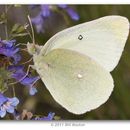Conservation Status
fornì da University of Alberta Museums
Not of concern.
- licensa
- cc-by-nc
- drit d'autor
- University of Alberta Museums
Cyclicity
fornì da University of Alberta Museums
Two broods, peaking in late May to mid June and late July to mid August.
- licensa
- cc-by-nc
- drit d'autor
- University of Alberta Museums
Distribution
fornì da University of Alberta Museums
This species occurs from central BC across to southern Saskatchewan, south to California and New Mexico (Opler 1999). In Alberta, it occurs chiefly along the southern reaches of the Red Deer River valley and southward. The depiction of locality records throughout the Alberta foothills in Layberry et al. (1998) is incorrect, and may be referable to C. christina; these two species were once considered to be variations of the same species.
- licensa
- cc-by-nc
- drit d'autor
- University of Alberta Museums
General Description
fornì da University of Alberta Museums
A combination of the following traits will usually distinguish this species: hindwing underside quite greenish, with no row of dark spots and an unbordered, silver discal spot; upperside bright, cold-yellow with no trace of orange. It is found only in prairie (rarely in the southern foothills) grassland habitat.
- licensa
- cc-by-nc
- drit d'autor
- University of Alberta Museums
Habitat
fornì da University of Alberta Museums
Gravelly and eroding prairie grasslands.
- licensa
- cc-by-nc
- drit d'autor
- University of Alberta Museums
Life Cycle
fornì da University of Alberta Museums
The eggs of Colorado populations are at first yellow-green, then turning pink, and are conical in shape with longitudinal ridges (Guppy & Shepard 2001). Mature larvae are black-dotted and green, with alternating dark and light longitudinal stripes (Layberry et al. 1998, Guppy & Shepard 2001). In Colorado, third instar larvae overwinter (Guppy & Shepard 2001). Pupae are yellowish-green with light markings that mimic leaf veins (Guppy & Shepard 2001).
- licensa
- cc-by-nc
- drit d'autor
- University of Alberta Museums
Trophic Strategy
fornì da University of Alberta Museums
There are no larval or adult diet data available for Alberta populations. A number of legume species are known larval host plants in the US, as summarized by Guppy & Shepard (2001). They include members of the genera Astragalus, Lathyrus, Oxytropis and Thermopsis which are all legumes (Fabaceae).
- licensa
- cc-by-nc
- drit d'autor
- University of Alberta Museums

